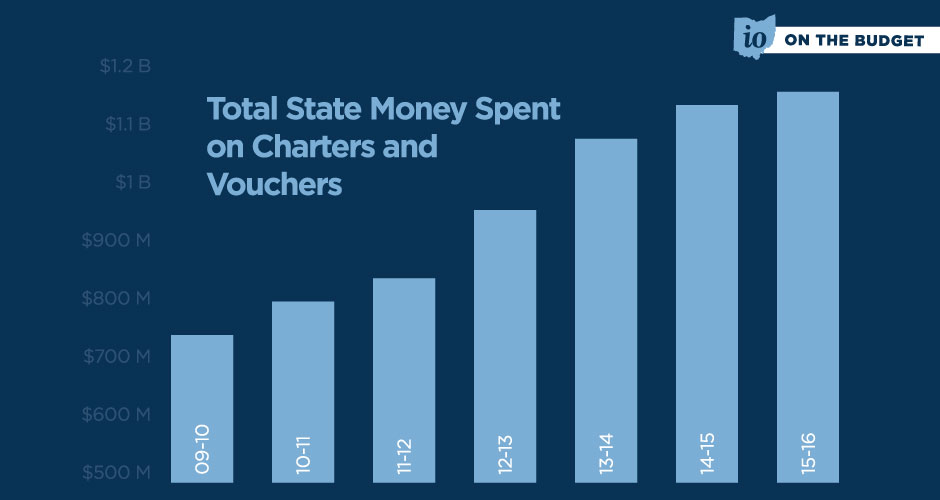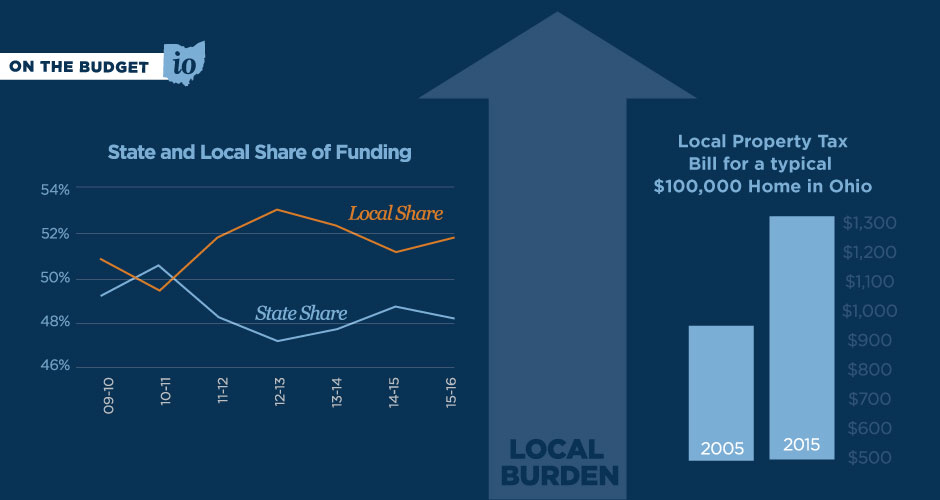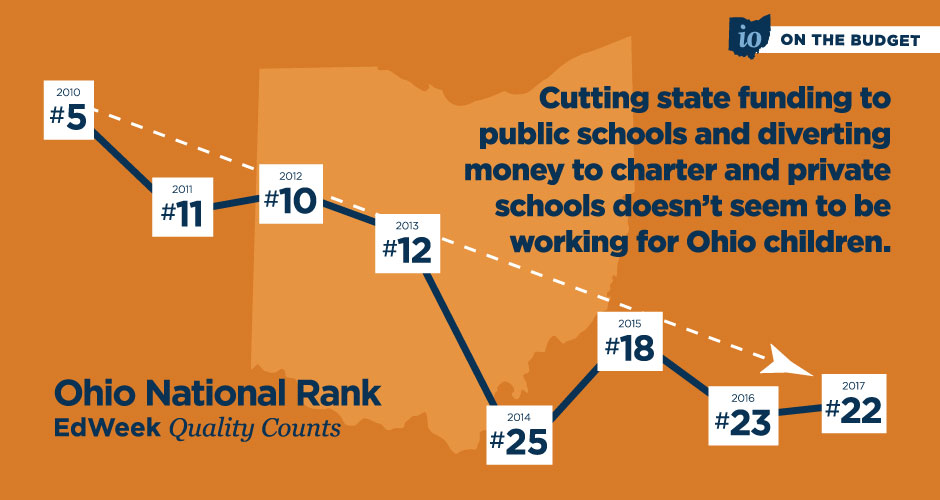What you need to know about Ohio Politics and Policy
Stephen Dyer · January 26, 2017
IO on the Budget: Education Funding Preview
The evidence is clear that the more and better educated a state’s population, the more healthy and prosperous our state will become. Yet, over the last six years, thanks to moves by Governor Kasich and state legislators, the State has consistently cut funding to local public schools while increasing funding to worse performing, privately run options, all while overseeing a precipitous drop in national education rankings. All while local property taxes are $1 billion more today than six years ago. As we await the release of Governor Kasich’s budget proposal Monday, we reflect on these recent trends and maintain our hope Ohio will reinvest in education to create a better future for our kids and communities.Past Budgets: Cuts are Cuts
Ohio has struggled with education funding since the 1990s, with four rulings by the Ohio Supreme Court that the way Ohio funds its schools is unconstitutional, primarily because the funding scheme is not based on actual costs and relies too much on property taxes to pay for it. Governor Kasich’s first budget in 2011 cut $1.8 billion from K-12 education, a loss that was not fully restored until 2015, but there remain winners and losers, namely:- Children in 110 districts have less funding in the 2016-2017 school year than they did in 2014-2015.
- Children in 317 districts will receive less than they did in the 2010-2011 school year, adjusted for inflation
 Meanwhile, Ohio’s nationally ridiculed charter school system has continued raking in the dough – each year receiving more state funding than the year before.
Charters put additional strain on children in local school districts because, when state funding is transferred from a local district along with a student, 92 percent of districts have been forced to find local revenue to replace it. And spending for the state’s private school voucher programs has exploded at an even greater rate, further eroding the state funding left for kids in local public schools.
Meanwhile, Ohio’s nationally ridiculed charter school system has continued raking in the dough – each year receiving more state funding than the year before.
Charters put additional strain on children in local school districts because, when state funding is transferred from a local district along with a student, 92 percent of districts have been forced to find local revenue to replace it. And spending for the state’s private school voucher programs has exploded at an even greater rate, further eroding the state funding left for kids in local public schools.
Current Challenges: Local Property Taxpayers Stand For Kids
Facing historic state cuts, Ohio’s local property taxpayers stood up admirably to fill the void. After six years of Kasich budgets, Ohio’s property taxpayers are paying more for education now than they ever have, with the average owner of a $100,000 home now paying nearly $1,200 a year in property taxes – a 22 percent jump from 10 years ago. This increase in local funding means that Ohio property taxpayers are paying $1 billion more for their children’s education today than they did the year before Kasich took office. Remember the Ohio Supreme Court ruled four times that relying too much on property taxes to pay for schools violated the state Constitution … 20 years ago.
Unsurprisingly, at the same time, Ohio’s national ranking has dropped to new lows. In 2010, Ohio was rated 5th in the nation for quality by Education Week. Today, Ohio ranks 22nd.
This increase in local funding means that Ohio property taxpayers are paying $1 billion more for their children’s education today than they did the year before Kasich took office. Remember the Ohio Supreme Court ruled four times that relying too much on property taxes to pay for schools violated the state Constitution … 20 years ago.
Unsurprisingly, at the same time, Ohio’s national ranking has dropped to new lows. In 2010, Ohio was rated 5th in the nation for quality by Education Week. Today, Ohio ranks 22nd.

What’s Next: Will Local Taxpayers Have To Keep Paying For State Failures?
Going into the next two-year budget, Kasich is warning the state is on the brink of a “recession” as tax collections dwindle, thanks in no small part to his addiction to tax cuts that primarily benefit the wealthy and well-connected. Will that mean less revenue to children in Ohio’s school districts? Gov. Kasich has already told his department heads to prepare to once again reduce budgets. In addition, he has promised to eliminate funding guarantees and caps in the state’s funding formula. Eliminating those tend to help kids in wealthier districts and hurt kids in districts losing students, which tend to be lower-income communities. Will Kasich and his allies will finally develop a funding formula that is based on the costs of providing a world-class education to Ohio’s 1.8 million students, and commit to relieving the burden of funding it currently overborne by local taxpayers? Will they find a way to fund Ohio’s many privatization options without fundamentally hurting children whose parents do not choose those mostly worse-performing options. Until the state fulfills its constitutional obligation to properly and adequately fund our children’s education, it is difficult to see the state leading the world into a new century of prosperity.Tagged in these Policy Areas: K-12 Education | Ohio State Budget


